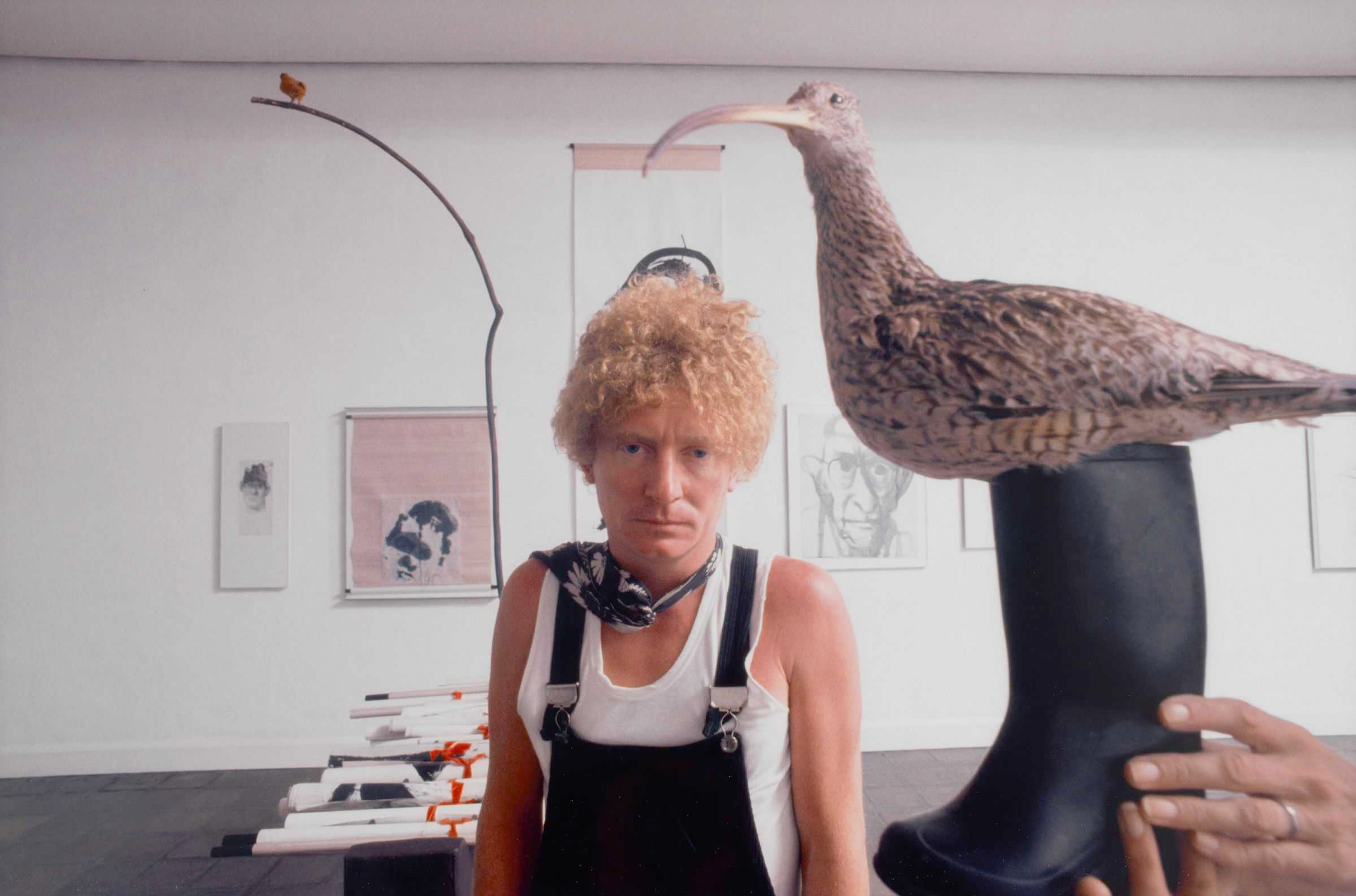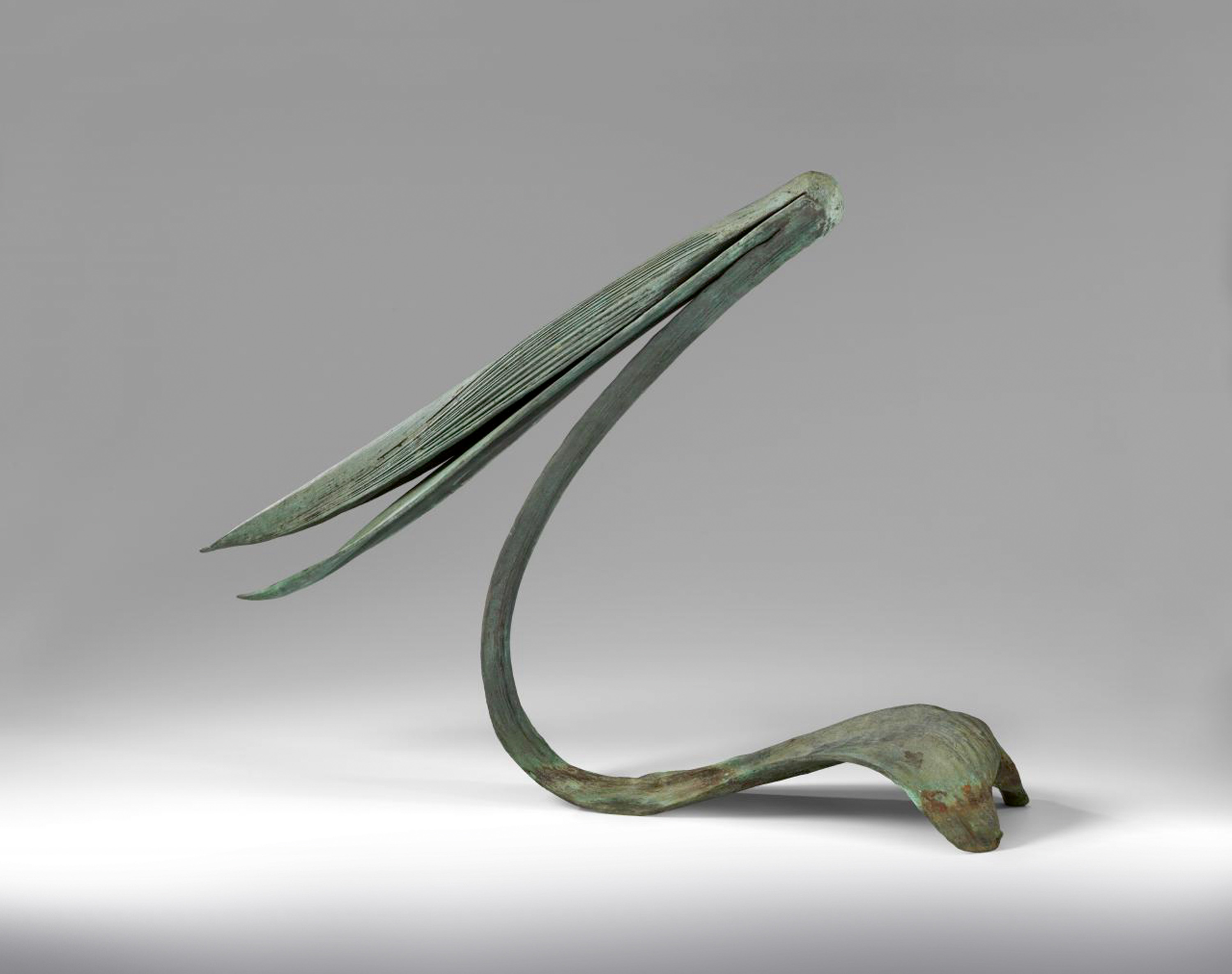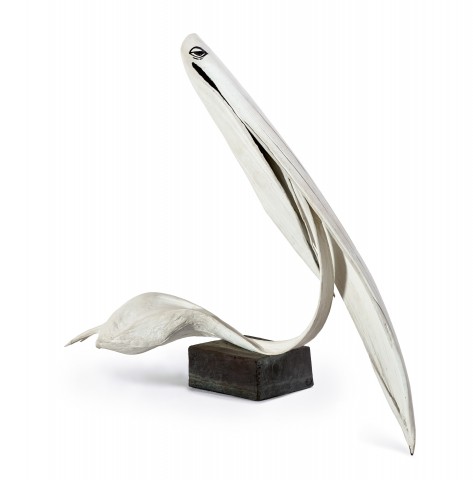PELICAN I, 1983
BRETT WHITELEY
painted bronze
89.0 x 93.0 x 29.0 cm
signed and numbered at base: brett whiteley 5/9.
bears Meridian Foundry stamp at base
Australian Galleries, Melbourne (stock no. 3979)
Private collection, Perth, acquired from the above in 1989
Brett Whiteley: some recent works: ’Birds’, ’The drought of 83’, Robin Gibson Gallery, Sydney, 30 July – 17 August 1983 (another example, painted palm frond and plaster maquette, not in catalogue)
An Exhibition by Brett Whiteley – Eden and Eve, Australian Galleries, Melbourne, 12 – 28 July 1984, cat. 8 (another example, as ‘Pelican’ 1983)
Brett Whiteley: Van Gogh Self Portraits, Greenhill Galleries, Perth, 27 January –22 February 1987, cat. 35 (another example, as ‘Pelican’) [cast not specified]
Birds, Brett Whiteley Studio, Sydney, 5 – 19 July 1988, cat. 55 [cast not specified]
Brett Whiteley: art and life, Art Gallery of New South Wales, Sydney, 16 September – 19 November 1995, cat. 140 (another example); Museum and Art Galleries of the Northern Territory, Darwin, 13 December 1995 – 28 January 1996; Art Gallery of Western Australia, Perth, 22 February – 8 April 1996; Art Gallery of South Australia, Adelaide, 9 May – 16 June 1996; National Gallery of Victoria, Melbourne, 2 July – 26 August 1996; Tasmanian Museum and Art Gallery, Hobart, 18 September – 19 November 1996
A Different Vision: Brett Whiteley Sculptures, Brett Whiteley Studio, Sydney, 4 April – 23 August 1998 (another example)
Animals and Birds, Brett Whiteley Studio, Sydney, 15 June – 6 October 2002 (another example)
On the Beach with Whiteley, Brett Whiteley Studio, Sydney, 1 March – 29 June 2003 (another example)
Whiteley and the third dimension, Brett Whiteley Studio, Sydney, 26 July 2008 – 15 March 2009 (another example)
Whiteley on Water, Hazelhurst Regional Gallery and Arts Centre, Sydney, November 2013 – February 2014 (another example)
Brett Whiteley: Sculpture and Ceramics, Brett Whiteley Studio, Sydney, 5 June – 6 December 2015 (another example)
Bohemian Harbour: The Artists of Lavender Bay, Museum of Sydney, Sydney, 1 September – 25 November 2018 (another example)
Gray, R., ‘A few takes on Brett Whiteley,’ Art and Australia, Vol. 24, No. 2, Summer, 1986, p. 223 (studio photograph, illus., another example)
McGrath, Vogue Living, November 1988, p. 152 (install photograph, illus., another example)
Pearce, B., Brett Whiteley: art and life, Art Gallery of New South Wales, Sydney, pl. 138, pp. 200 (illus., another example), 234
Sutherland, K., Brett Whiteley: Catalogue Raisonné: 1955 – 1992, Schwartz Publishing, Melbourne, 2019, cat. 62s, vol. 6, p. 186 (illus. another example), vol. 7, pp. 893 – 94
Pelican [unpainted], 1983, bronze, 85.0 × 91.5 × 30.5 cm, in the collection of the National Gallery of Victoria, Melbourne [edition: 1/9]
Pelican II, 1988, bronze, 77.3 x 96.0 x 40.0 cm
Whiteley spreawd Righr.jpg

At the time that Pelican I was made in 1983, Brett Whiteley was at the height of his powers, with an enviable international career that saw him establish a friendship with Dire Straits bass player John Isley, and lead singer and guitarist Mark Knopfler, during the Australian leg of the band’s Love Over Gold tour, and later design the cover of their 1984 album Alchemy. Whiteley’s alcohol and drug-fuelled high living during the early 1980s however, in no way dampened his creative output, with the artist continuing to produce significant works across painting, drawing and sculpture. In 1983 alone, Whiteley’s work was the subject of his first exhibition at the Art Gallery of New South Wales, Another Way of Looking at Vincent van Gogh (curated by the museum’s director, the late Edmund Capon AM OBE), along with concurrent exhibitions in Sydney – Some Recent Works: Birds (11) The Drought of 83 (7) Animals at Robin Gibson Gallery, and in Brisbane, at Philip Bacon Galleries. Whiteley’s van Gogh extravaganza had already been preceded by the Melbourne exhibition Life and Death: A Visual Experience in Opposites at Australian Galleries in June and was followed by an exhibition of prints in Canberra later that year.1 While not only demonstrating the artist’s incredible capacity to produce, the five exhibitions that Whiteley held in 1983 collectively showcase his expansive and voracious thinking, his ability to turn his hand with success to a variety of mediums, and the extraordinary diversity of his influences and interests.
Dg102435_cmyk.jpg

Throughout his career, Whiteley had become renowned for exploring subjects of great difference in the one exhibition, often to the confusion of critics. This practice not only reflected his remarkable ability to jump from subject to subject, but also fuelled his drive to create. As he reflected:
‘Although completely different in style and intention, working on divergent themes at the same time has greatly helped both to exist more intensely… The experience of being able to change concentration quickly has led me to watching two television sets at the same time, enjoying and following both programmes by split-second shifting of focus and audial concentration.’2
Animals and the natural world featured prominently in this idiosyncratic way of working, providing a sense of release and escape from more confronting material. Birds in particular held a special place in Whiteley’s heart, and birds, eggs and nests occur as subjects – as large-scale sculptures such as Newcastle Art Gallery’s Black Totem II, 1993, for example – and as real-life collage elements, across the artist’s oeuvre. Throughout his career, Whiteley created sculptures from found objects, while also displaying mastery of more traditional techniques such as carving and casting, and he clearly relished thinking and working in three-dimensions. The singular appearance of the pelican, with its long beak and large throat pouch, obviously appealed, with it appearing in the artist’s book of sketches made at Taronga Park Zoo in 19793, in a number of drawings, and even as the subject for the charming bookplate that Whiteley produced for Barbara Corrigan during the 1970s (National Gallery of Australia).
Part of an edition of nine, the difference between the artist’s treatment of Pelican I and another sculpture from the edition such as Pelican, 1983 (National Gallery of Victoria), highlights Whiteley’s almost insatiable desire to push the boundaries, even across a series of editioned works. The NGV’s sculpture is cast in bronze with a traditional Verdigris patina, whereas Pelican I, as with some other examples from the edition, is finished with the artist’s painted surface and painted eyes. Explaining variations in appearance and scale Kathie Sutherland notes, ‘After casting, the separate parts of the sculpture are put together by hand. This process, which may be described as the geometry of assemblage, is largely dependent upon the whim of the artist, or foundry technician and frequently results in variations in the height and angles of individual sculptures within the same edition.’4
The graceful lines and streamlined form of Pelican I perfectly embodies Whiteley’s capacity to hold figuration and abstraction in a beautiful tension, where the capacity and possibilities of one way of working effectively feed into and bolster the achievements of the other. As he observed: ‘Anything that is beautiful is a unique mixture of abstraction, realism, and expressionism: if one is neglected or overdone, if one is not considered in the light of the other, if in fact the three forces are not felt as one, in one brilliant flash of a glimpse – inspiration will be missing and eventually meaning.’5
Pelican I’s focus on the bird’s commanding beak epitomises Whiteley’s ability to masterfully capture function – the way in which the pelican catches caches of fish in its throat pouch, which serves as a kind of dip-net – with form, as the curve of the bird’s beak and stylised body imply both purpose and action. However, in painting over the bronze to highlight the pelican’s eye, Whiteley not only conveys his deep and personal connection to the natural world but transforms his sculpture into a conscious being that seems to knowingly observe the world around it.
1. Wilson, A., Brett Whiteley: Art, Life and the Other Thing, The Text Publishing Company, Melbourne, 2016, p. 327
2. Ibid., p. 320
3. Whiteley, B., Zoo, Pegasus, Melbourne, 1979
4. Sutherland, K., Brett Whiteley: Catalogue Raisonné: 1955 – 1992, Schwartz Publishing, Melbourne, 2019, p. 894
5. Whiteley, writing about drawing in the catalogue for his exhibition at Robin Gibson Gallery, Sydney in 1985 (162 drawings Brett Whiteley 1960 – 85, Robin Gibson Gallery, Sydney, 19 October – 6 November 1985), quoted in Wilson, op. cit., pp. 345 – 46
KELLY GELLATLY
